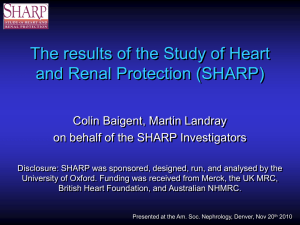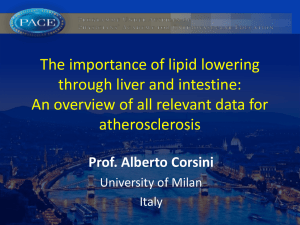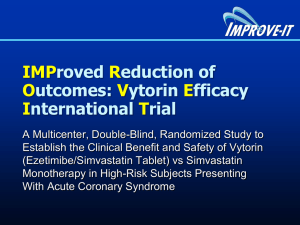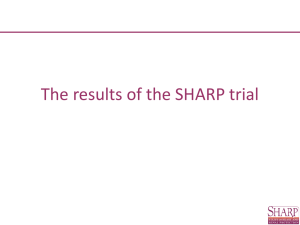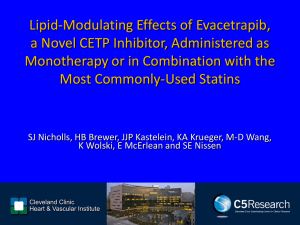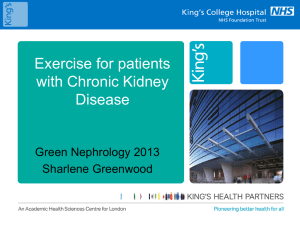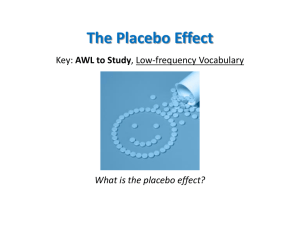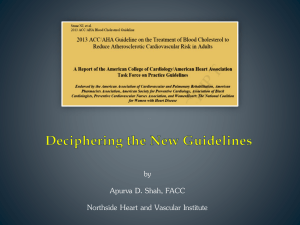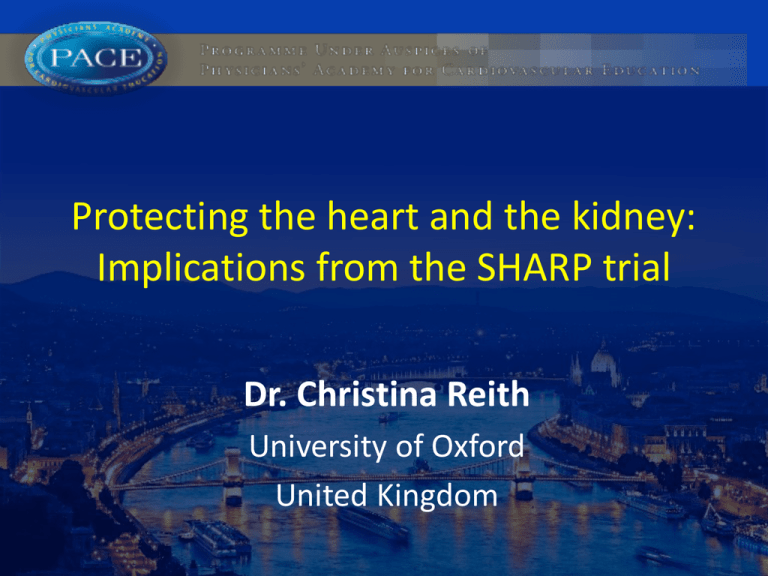
Protecting the heart and the kidney:
Implications from the SHARP trial
Dr. Christina Reith
University of Oxford
United Kingdom
Outline of presentation
• Lowering LDL cholesterol in non-renal
patients
• Lowering LDL cholesterol in renal disease
• Study design of SHARP
• Main results of SHARP
• Conclusions
Cholesterol Treatment Trialists
(CTT) Collaboration
• Collaborative
meta-analysis of individual participant data from
randomized trials of LDL-cholesterol (LDL-C) lowering therapy
• Allows detailed analyses of effects of statins:
–
Efficacy outcomes: Major vascular events (major coronary events,
stroke, or coronary revascularization); vascular mortality
–
–
Safety outcomes: Cancer (site-specific); non-vascular mortality
–
By follow-up time (eg, with more prolonged treatment)
Major subgroups: Efficacy and safety in different types of patients
(eg, by baseline LDL cholesterol, or by stage of kidney disease)
• Current cycle:
–
–
–
21 trials of statin versus control
5 trials of more versus less intensive statin
24,000 major vascular events among 170,000 participants
CTT Collaboration Lancet 2010
CTT meta analysis: Proportional reduction
in MAJOR VASCULAR EVENTS versus
absolute LDL-C reduction
Proportional reduction in
vascular event rate (95% CI)
30%
25%
20%
Statin vs. control
(21 trials)
More vs. Less
(5 trials)
15%
22% (20%-24%)
risk reduction
per 1 mmol/L (39mg/dL)
P<0.0001
10%
5%
0%
0.0
20
Mean LDL cholesterol difference
between treatment groups (mg/dL)
40
CTT Collaboration
Lancet 2010
CTT: Similar relative reductions in MVE risk
per 40 mg/dL LDL-C reduction, irrespective
of presenting LDL-C
No. of events (% pa)
Presenting
LDL-C (mg/dL) More statin Less statin
<80
80 <100
Relative risk (CI)
100 <120
120 <140
140
704 (4.6)
1189 (4.2)
1065 (4.5)
517 (4.5)
303 (5.7)
795 (5.2)
1317 (4.8)
1203 (5.0)
633 (5.8)
398 (7.8)
0.71 (0.52 - 0.98)
0.77 (0.64 - 0.94)
0.81 (0.67 - 0.97)
0.61 (0.46 - 0.81)
0.64 (0.47 - 0.86)
Total
3837 (4.5)
4416 (5.3)
0.72 (0.66 - 0.78)
0.5
Trend test: 2 on 1 df = 2.04 ; p=0.2
CTT Collaboration Lancet 2010
0.75
More statin
better
1
1.25
1.5
Less statin
better
Cardio-renal phenotype: Reasons
the effects of LDL-lowering may
differ in CKD patients
Arteries
• Atherosclerosis
• Increased wall thickness
• Arterial stiffness
• Endothelial dysfunction
• Arterial calcification
• Systolic hypertension
Heart
• Structural disease (ie, ventricular
re-modelling)
• Ultrastructural disease (ie, myocyte
hypertrophy and capillary reduction)
• Reduced left ventricular function
• Valvular diseases (hyper-calcific
mitral/aortic sclerosis or stenosis)
• Conduction defects and arrhythmias
Dialysis patients: minority of
vascular deaths are atherosclerotic
Cancer
4%
Other
29%
Infection
15%
Stroke
5%
Acute MI
8%
Other CHD
3%
27%
USRDS 2005 Annual Data Report
Cardiac arrest/
arrhythmia
27%
Other
cardiac
5%
Unknown
4%
CTT: Previous lack of evidence for
reduction in MVE risk in people with
eGFR below 30 mL/min/1.73m2
No. of events
Statin
Control
Relative risk (CI)
46 (4.8%)
43 (6.1%)
0.82 (0.44 - 1.55)
30 < 45
313 (4.7%)
393 (6.0%)
0.77 (0.65 - 0.93)
45 < 60
1154 (3.9%)
1480 (5.1%)
0.79 (0.72 - 0.86)
60 < 90
3416 (3.2%)
4244 (4.1%)
0.80 (0.76 - 0.84)
90
671 (2.9%)
915 (4.1%)
0.73 (0.65 - 0.82)
Total
5802 (3.1%)
7344 (4.0%)
0.78 (0.76 - 0.81)
Estimated GFR
(mL/min/1.73m2)
< 30
99% or
95% CI
Trend test: 2 on 1 df = 0.61 ; p=0.43
CTT Collaboration Lancet 2010
0.4
0.6
0.8
Statin/more
better
1
1.2
1.4
Control/less
better
4D trial: Inconclusive evidence
about the benefits of statin
therapy in CKD patients
Study population:
1255 hemodialysis patients
with Type 2 diabetes
Treatment:
Atorvastatin 20mg vs placebo
LDL-C difference:
1.0 mmol/L (39 mg/dL)
Follow-up:
4 years
Primary endpoint:
Composite of:
- Non-fatal MI or cardiac death; and
- Non-fatal or fatal stroke
RR 0.92 (95% CI 0.77 to 1.10); P=0.37
Wanner et al N Engl J Med 2005
AURORA trial: Inconclusive
evidence about the benefits of
statin therapy in CKD patients
Study population:
2766 hemodialysis patients
Treatment:
Rosuvastatin 10mg vs placebo
LDL-C difference:
1.1 mmol/L (43 mg/dL)
Follow-up:
3.8 years
Primary endpoint:
Composite of:
- Non-fatal MI or cardiac death;
- Non-fatal or fatal stroke; and
- Other vascular death
RR 0.96; 95% CI 0.84 to 1.11; P = 0.59
Fellstrom et al N Engl J Med 2009
SHARP designed to fill a gap in the evidence
on lowering LDL-C in CKD patients
• Does LDL-lowering therapy reduce risk of
atherosclerotic
disease in CKD patients?
– Exclusion of CKD patients from most statin trials
– Previous statin trials in CKD patients inconclusive
• Can such a reduction be achieved safely?
– Concerns about safety of statins in CKD patients
– Combination of ezetimibe with moderate statin dose
intended to minimize side-effects
Study design of sharp
LDL lowering regimen in SHARP
• CTT indicated that relative benefit likely to be proportional
to absolute LDL reduction
• Patients with CKD have average or below average LDL
cholesterol (unless nephrotic)
• To maximise benefit, need intensive LDL lowering
regimen in CKD
• BUT, high-dose statins NOT SAFE in CKD
• SHARP used simvastatin 20mg plus ezetimibe 10mg
SHARP: Sensitive to
potential benefits
• Emphasis on detecting effects on ATHEROSCLEROTIC
outcomes
– INCLUSION of coronary and non-coronary
revascularization procedures
– EXCLUSION of hemorrhagic stroke and non-coronary
cardiac death from key outcome
SHARP: Wide inclusion
criteria
• History of chronic kidney disease (CKD)
– Not on dialysis: elevated creatinine on 2 occasions
• Men: ≥1.7 mg/dL (150 µmol/L)
• Women: ≥1.5 mg/dL (130 µmol/L)
– On dialysis: hemodialysis or peritoneal dialysis
• Age ≥40 years
• No history of myocardial infarction or coronary
revascularization
SHARP: Study Design
11,792 Screened
6-week placebo run-in
9,438
Randomized
1 year
4,193
Eze/Simva
1,054 Simvastatin
4,191
Placebo
+ 457
886 re-randomized
+ 429
Effects of ezetimibe on:
• Safety outcomes
• Lipid profile
4,650 Eze/Simva
10/20 mg
Median follow-up = 4.9 years
Main analyses of safety and efficacy
4,620
Placebo
SHARP: Baseline characteristics
Characteristic
Age
Men
Systolic BP (mm Hg)
Diastolic BP (mm Hg)
Body mass index
Current smoker
Vascular disease
Diabetes mellitus
Non-dialysis patients only
eGFR (mL/min/1.73m2)
Albuminuria
Mean (SD) or %
62 (12)
63%
139 (22)
79 (13)
27 (6)
13%
15%
23%
(n=6247)
27 (13)
80%
Renal status at randomization
Number
Pre-dialysis
Percent
eGFR*
88
1%
45-59
302
3%
Stage 3B
30-44
1853
20%
Stage 4
15-29
2565
28%
Stage 5
<15
1221
13%
Subtotal: pre-dialysis
6029
67%
Hemodialysis
2527
28%
496
5%
Subtotal: dialysis
3023
33%
ALL PATIENTS
9052
100%
Stages 1/2
≥60
Stage 3A
Peritoneal dialysis
*eGFR in mL/min/1.73m2
Lipid profile (mg/dL) at randomization
Number
Percent
<174
3434
39%
≥174 <212
3049
34%
≥213
2410
27%
<97
3483
39%
≥97 <116
2096
24%
≥116
3313
37%
Total-C (mean 189 mg/dL)
LDL-C (mean 108 mg/dL)
Impact of net compliance with study
treatment on achieved LDL-C differences
during the trial
Time
period
LDL- lowering drug use
LDL-C difference (mg/dL)
eze/
simva
placebo
Net
compliance
eze/
simva
placebo
Absolute
difference
~ 1 year
77%
3%
74%
-42
+1
-42
~ 2.5 years
71%
9%
61%
-39
-6
-33
~ 4 years
68%
14%
55%
-32
-3
-30
Net compliance is defined as the difference between groups in the proportion that
were taking at least 80% of study treatment or a non-study statin
SHARP: Muscle safety
eze/simva placebo
(n=4650) (n=4620)
CK >10 x ≤40 x ULN (ITT)
17 (0.4%)
16 (0.3%)
CK >40 x ULN (ITT)
4 (0.1%)
5 (0.1%)
Myopathy* (ITT)
9 (0.2%)
5 (0.1%)
Myopathy* (on treatment)
8 (0.2%)
3 (0.1%)
Rhabdomyolysis (ITT)†
4 (0.1%)
1 (0.0%)
Rhabdomyolysis (on treatment)†
4 (0.1%)
0 (0.0%)
ITT = randomised “intention-to-treat” comparison
*Myopathy defined as CK > 10 x ULN with muscle symptoms
†Rhabdomyolysis defined as myopathy with CK > 40 x ULN
SHARP: Liver safety
Hepatitis
Infective
Non-infective
No cause identified
Any hepatitis
ALT/AST persistently >3x ULN
eze/simva
(n=4650)
placebo
(n=4620)
12 (0.3%)
6 (0.1%)
12 (0.3%)
4 (0.1%)
3 (0.1%)
21 (0.5%)
3 (0.1%)
18 (0.4%)
30 (0.6%)
26 (0.6%)
SHARP: Cancer incidence
Proportion suffering event (%)
25
20
Risk ratio 0.99 (0.87-1.13)
Logrank 2P=0.89
15
eze/simva
placebo
10
5
0
0
1
2
3
Years of follow-up
4
5
No beneficial (or adverse) effect on
pre-specified renal outcomes
Event
eze/simva placebo
(n=3117) (n=3130)
Risk ratio & 95% CI
Main renal outcome
End-stage renal disease
1057 (33.9%) 1084 (34.6%)
0.97 (0.89-1.05)
ESRD or death
1477 (47.4%) 1513 (48.3%)
0.97 (0.90-1.04)
ESRD or 2 x creatinine
1190 (38.2%) 1257 (40.2%)
0.93 (0.86-1.01)
Tertiary renal outcomes
0.6
0.8
1.0
eze/simva
better
1.2
1.4
placebo
better
Key outcome: Major
Atherosclerotic Events
Proportion suffering event (%)
25
20
Risk ratio 0.83 (0.74-0.94)
Logrank 2P=0.0021
15
placebo
eze/simva
10
5
0
0
1
2
3
Years of follow-up
4
5
Benefit for both MAEs and MVEs
Event
eze/simva
(n=4650)
placebo
(n=4620)
Major coronary event
Non-hemorrhagic stroke
Any revascularization procedure
213
131
284
230
174
352
(4.6%)
(2.8%)
(6.1%)
Risk ratio & 95% CI
(5.0%)
(3.8%)
(7.6%)
0.83 (0.74-0.94)
p=0.0021
Major Atherosclerotic Event
526 (11.3%)
619 (13.4%)
Other cardiac death
Hemorrhagic stroke
162
45
(3.5%)
(1.0%)
182
37
(3.9%)
(0.8%)
Other Major Vascular Events
207
(4.5%)
218
(4.7%)
0.94 (0.78-1.14)
p=0.56
Major Vascular Event
701 (15.1%)
814 (17.6%)
0.85 (0.77-0.94)
p=0.0012
0.6
0.8
1.0
eze/simva
better
1.2
1.4
placebo
better
SHARP consistent with 4d and aurora
trials in dialysis patients
Comparing 4D, AURORA and SHARP:
methodological considerations
• Meta-analyses of patient-level data from CTT
• Primary endpoints differed importantly:
– SHARP did not include non-coronary cardiac deaths
or hemorrhagic stroke, whereas 4D and AURORA did
– Only SHARP included revascularization procedures
• In AURORA, almost all of the cardiac deaths
were coded as being coronary in nature
• Hence, comparisons most valid for endpoints that
were defined similarly in the 3 trials (ie, vascular
death; MI; stroke; and coronary revascularization)
4D, AURORA and SHARP:
Coronary revascularization
Events (% pa)
Allocated
LDL-C reduction
Allocated
control
Risk ratio (RR) per
mmol/L LDL-C reduction
Coronary revascularization
4D
55 (3.31)
72 (4.29)
AURORA
55 (1.20)
70 (1.53)
SHARP
149 (0.79)
203 (1.09)
Subtotal: 3 trials
259 (1.03)
345 (1.38)
0.72 (0.60 - 0.86)
Other 24 trials
5243 (1.54)
6665 (1.98)
0.75 (0.72 - 0.78)
All trials
5502 (1.50)
7010 (1.94)
0.75 (0.72 - 0.77)
99% or
0.5
0.75
1
LDL-C reduction
better
95% CI
Heterogeneity between renal trials:
2 = 0.4 (p = 0.82)
2
Difference between renal and non-renal trials:
2 = 0.1 (p = 0.72)
1
1.5
Control
better
2
4D, AURORA and SHARP:
Comparison of outcomes
1400
Number of events
1200
1000
800
600
400
200
0
Revascularization
Nonfatal stroke
Nonfatal MI
Vascular death
4D
AURORA
62
142
265
92
194
518
SHARP
484
204
256
201
MAJOR ATHEROSCLEROTIC EVENTS
BY SUBGROUPS
SHARP: Major Atherosclerotic
Eventsby sex and age
eze/simva
(n=4650)
placebo
(n=4620)
Sex
Male
Female
376 (12.9%)
150 (8.6%)
445 (15.4%)
174 (10.0%)
Age at randomization (years)
40-49
50-59
60-69
70+
56 (5.8%)
85 (7.3%)
163 (13.3%)
222 (17.1%)
50 (5.5%)
119 (10.4%)
171 (13.7%)
279 (21.2%)
Major Atherosclerotic Event
526 (11.3%)
619 (13.4%)
No significant heterogeneity:
(i) by sex (p=0.9)
(ii) by age (p=0.44)
Risk ratio & 95% CI
0.83 (0.74-0.94)
p=0.0021
0.6
0.8
1.0
eze/simva
better
1.2
1.4
placebo
better
SHARP: Major Atherosclerotic Events
by prior vascular disease or diabetes
eze/simva
(n=4650)
placebo
(n=4620)
Prior vascular disease
Coronary disease
Peripheral arterial disease
Cerebrovascular disease
At least one of above 3 conditions
None
36
82
74
167
359
35
87
77
172
447
Diabetes
No diabetes
Diabetes
333 (9.3%)
193 (18.3%)
385 (10.8%)
234 (22.5%)
Major atherosclerotic event
526 (11.3%)
619 (13.4%)
(21.3%)
(27.0%)
(22.0%)
(23.5%)
(9.1%)
No significant heterogeneity:
(i) by prior vascular disease (p=0.27)
(ii) by history of diabetes (p=0.45)
Risk ratio & 95% CI
(24.6%)
(29.0%)
(24.5%)
(25.2%)
(11.4%)
0.83 (0.74-0.94)
p=0.0021
0.6
0.8
1.0
1.2
1.4
eze/simva placebo
better
better
SHARP: Major Atherosclerotic
Events by CKD stage
eze/simva placebo
(n=4650) (n=4620)
Risk ratio & 95% CI P value for
Het/Trend
MDRD estimated GFR (mL/min/1.73m²)
≥ 60 (stage 2)
3 (6.8%)
3 (6.8%)
≥ 45< 60 (stage 3a)
6 (4.2%) 17 (10.8%)
≥ 30 <45 (stage 3b)
81 (8.5%) 93 (10.4%)
≥ 15 < 30 (stage 4)
127 (10.2%) 168 (12.7%)
<15 (stage 5)
67 (10.9%) 81 (13.3%)
Subtotal: Not on dialysis
296 (9.5%) 373 (11.9%)
Dialysis
Hemodialysis
Peritoneal dialysis
194 (15.2%) 199 (15.9%)
36 (14.0%) 47 (19.7%)
Subtotal: On dialysis
230 (15.0%) 246 (16.5%)
Major atherosclerotic event
526 (11.3%) 619 (13.4%)
0.50
0.78 (0.67-0.91)
p=0.0016
0.21
0.90 (0.75-1.08)
p=0.25
0.83 (0.74-0.94)
p=0.0021
0.6
0.8
1.0
1.2
1.4
eze/simva better placebo better
25
20
Statin vs control
(21 trials)
More vs less
(5 trials)
Not on dialysis
(22% MAE risk
reduction)
15
SHARP
(17% MAE risk
reduction)
5
10
Dialysis
(10% MAE risk
reduction)
0
Proportional reduction in event rate (95% CI)
30
CTT: Effect on major
vascular/atherosclerotic events by
trial-midpoint LDL-C reduction
0
10
20
Mean LDL cholesterol difference
between treatment groups (mg/dL)
30
40
SHARP: Effects on Major
Atherosclerotic Events (per 40 mg/dL
LDL-C reduction) by renal status
eze/simva
(n=4650)
placebo
(n=4620)
Non-dialysis
296
(9.5%)
373 (11.9%)
Dialysis
230 (15.0%)
246 (16.5%)
Major atherosclerotic event
526 (11.3%)
619 (13.4%)
Risk ratio & 95% CI
0.81 (0.70-0.93)
per mmol/L
p=0.0021
0.6
Test for heterogeneity after LDL weighting p=0.65
0.8
eze/simva
better
1.0
1.2
1.4
placebo
better
SHARP: Summary of findings
• Allocation to eze/simva produced:
– mean study LDL-C reduction of 33mg/dL
– 17% reduction in major atherosclerotic events
• Similar, and significant, reductions in both:
– Major atherosclerotic events (p=0.0021)
– Major vascular events (p=0.0012)
• Longer treatment, and better compliance, would be
expected to lead to larger benefits
• No evidence of serious adverse effects with eze/simva in
vulnerable CKD patient population
SHARP: Public health impact of findings
• Intention-to-treat analyses indicate that 21 per 1000
fewer patients had MAE over about 5 years (NNT=48)
• Or, more appropriately, SHARP indicates that 21,000
fewer per million would have had MAE over 5 years
• Benefits are similar to those seen with LDL-lowering
therapy in other high-risk groups (eg, diabetic patients)
• Observed benefit is an underestimate of actual use:
– Longer treatment and better compliance would be expected
to yield even larger reductions in absolute risk of events
– SHARP excluded highest risk patients (eg, those with CHD)

